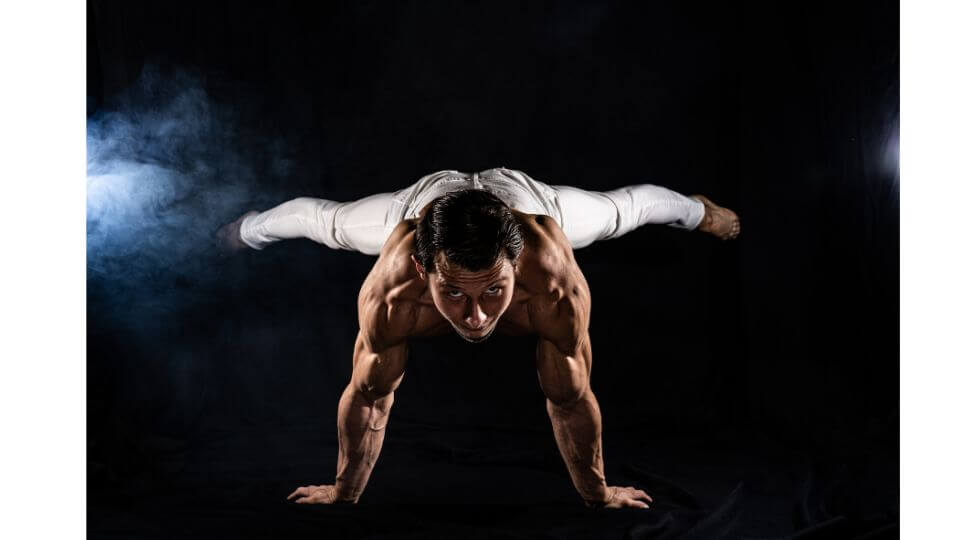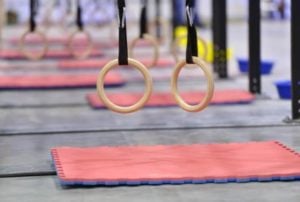It’s important to clarify that this is not a comprehensive list of the most difficult exercises. We picked 10 challenging calisthenics moves that can be mastered with progression training. We grouped them into isotonic and isometric categories based on whether one repetition is defined as a few seconds of static hold or if it consists of concentric and eccentric motion in order to complete.
If you are a complete beginner then I'd recommend starting with our ▶️ recommended resources for calisthenics and if you are ready follow our ▶️ free 4-week workout plan for total beginners that you can do at home without any equipment.
Cool Calisthenics Isotonic Exercises
All of these calisthenics moves require a great deal of strength and coordination but with consistent and smart training even beginners can achieve them. If you are just getting started it is common sense that before attempting to perform these - in order to avoid injury - it's best to build up your strength with the easiest calisthenics moves first and gradually increase resistance by adjusting your leverage or adding weight. This way you can safely progress towards more advanced calisthenics moves. Below we chose 5 examples of some of the hardest calisthenics moves in the isometric category that you can use as inspiration and gradually progress towards.
Isotonic exercises are a type of strength training in which the muscle length changes while the muscle tension remains constant. This means that the muscle contracts and shortens while lifting a weight, and then lengthens while lowering the weight. Examples of isotonic exercises include weightlifting (such as bench press, bicep curl), calisthenics (such as push-ups, pull-ups) and resistance band exercises. These exercises can be used to increase muscle strength, endurance, and muscle size (hypertrophy). They are also known to improve overall fitness and functional movement.
Handstand Push-Up

A handstand push-up targets the muscles in the shoulders, chest, and triceps. It requires a significant amount of core strength and balance. The main muscles engaged in the handstand are the deltoids, which are the muscle of the shoulders and the triceps. The chest, triceps and core are also engaged. It's recommended to start by practicing handstands against a wall, and then progress to using a spotter or wall for support, and work your way up to the full free handstand. For warm up, it's recommended to prepare the wrist joints to avoid any injuries.
Pistol Squat
A pistol squat, also known as a one-legged squat, is a challenging exercise that targets the muscles in the legs, glutes, and core. It requires a significant amount of balance and strength in the legs and core. It's recommended to start with assisted pistol squats using a pole or surface for support and work your way up to the full movement.
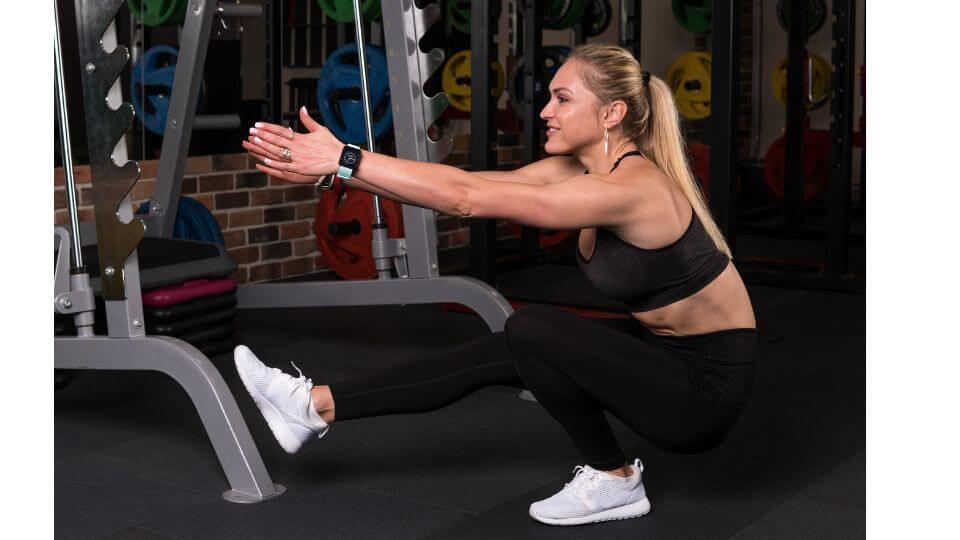
To perform a pistol squat, begin by standing on one leg with the other leg extended out in front of you. Slowly lower your body towards the ground by bending the knee of the standing leg, keeping your back straight and your chest up. Keep your extended leg straight and your foot flexed. Make sure to keep your weight balanced over your standing leg and your knee in line with your foot. Go down as low as you can while keeping good form and then push back up to the starting position.
Muscle Up
The muscle-up is a challenging exercise that requires upper body and core strength, as well as coordination and technique. It targets several muscle groups, including the shoulders, biceps, triceps, back, and chest. It is a highly versatile exercise, it can be done on rings, pull-up bars, or parallel bars.

This exercise is considered difficult due to the combination of pulling and pushing motions required and the need to generate enough force to lift the body over the bar. Combining them, the muscle-up requires a significant amount of upper body strength, as well as the coordination and technique to smoothly transition between the pull-up and dip portions of the exercise
Skin the Cat
The skin the cat exercise is a gymnastics movement that primarily works the shoulders, upper back and abdominal muscles. The exercise is performed on gymnastics rings or a pull-up bar and involves hanging from the rings or bar with straight arms and then pulling the body up and over, so that the legs and hips pass through the arms.
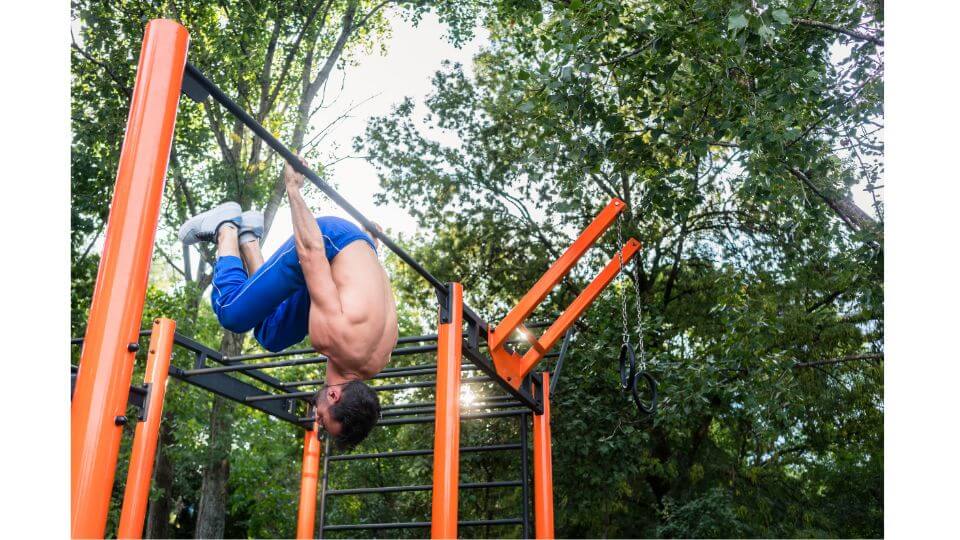
Besides being a great strengthening exercise skin the cat is also an excellent warm-up exercise or can be used for conditioning repetitions as part of high-intensity training.
One Arm Chin-Up
A one-arm chin-up is a variation of the traditional chin-up exercise, in which the individual uses only one arm to pull their body up to a chin-up bar. This exercise primarily engages the muscles of the back, including the latissimus dorsi (lats), the biceps, and the forearms. Additionally, it also works the core muscles, such as the abs and obliques, as well as the muscles of the shoulder.
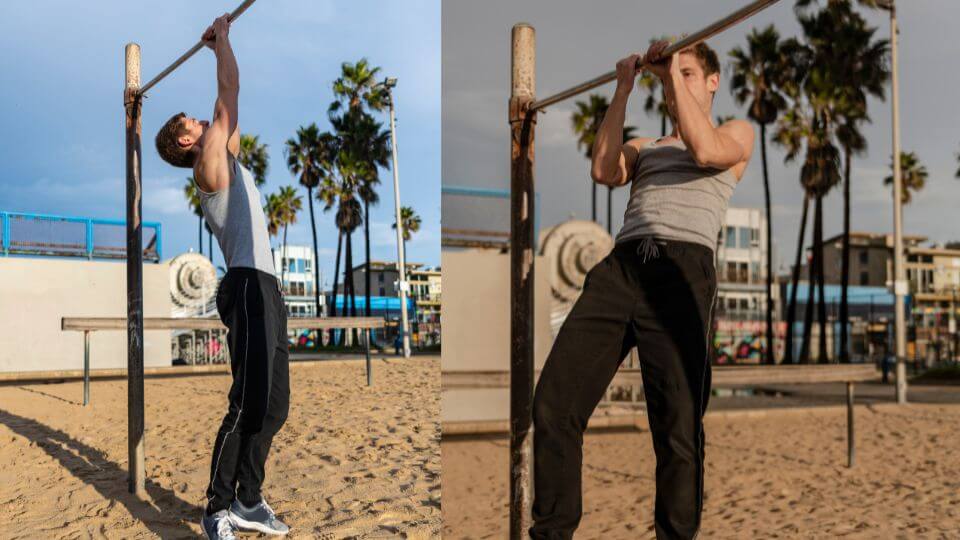
One-arm chin-ups are considered a good exercise for several reasons. Firstly, because it is a pull-up variation, it is an excellent exercise for building upper body strength and muscle mass. Secondly, it requires a high degree of balance and stability, which makes it a great exercise for developing core strength and stability. Furthermore, it is a compound exercise, meaning it engages multiple muscle groups at once, making it a time-efficient exercise. It is important to use proper form and start with a lower rep range, building up to more reps as your strength and skill increases.
Cool Calisthenics Moves in the Isometric Category
Isometric exercises are a type of strength training in which the muscle length does not change during contraction. This means that the muscle tension is increased without any visible movement in the joint. Examples of isometric exercises include holding a plank position, wall sits, and holding a weight in a fixed position. These exercises can be used to increase muscle strength and endurance, but they may not be as effective at increasing muscle size (hypertrophy) as exercises that involve movement, such as weightlifting.
Handstand
A handstand is an exercise in which a person supports their body weight on their hands while their feet are elevated above their head. It engages the muscles in the shoulders, arms, and core, including the triceps, deltoids, and rotator cuff muscles in the shoulders, as well as the abdominal and back muscles.
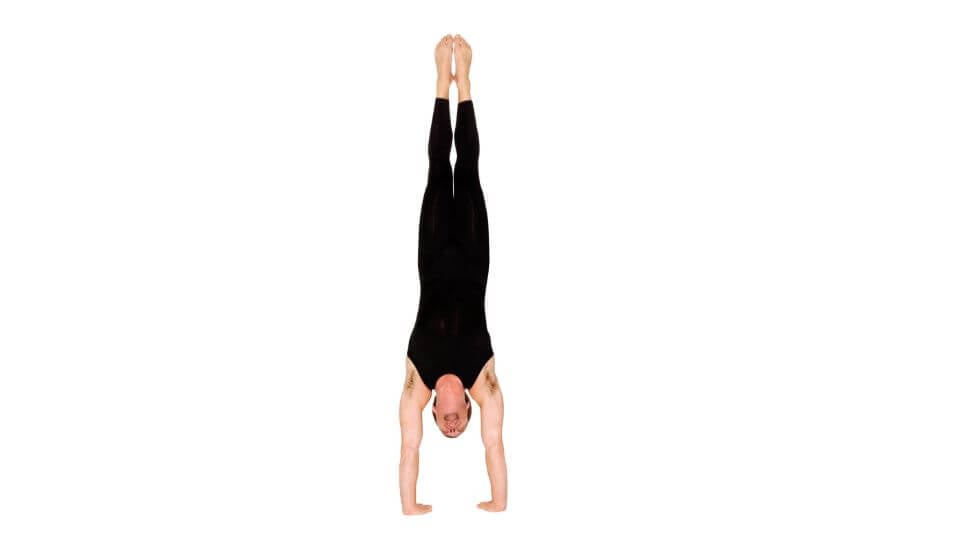
The benefits of this exercise are many and varied, including improved blood and lymph circulation, detoxification of the body, correction of posture, and stress relief. Additionally, handstands can improve memory and brain function. It is recommended to start slowly and with the help of a wall, gradually building up the duration and strength of the exercise. It is important to note that if you have any heart conditions or problems that would prevent you from practicing headstands, it is best to consult with a doctor before beginning this exercise.
Human Flag
The human flag is one of the coolest calisthenics moves people often use to show off on the beach. This exercise requires a great deal of upper body and core strength, as well as balance and control. To perform the human flag, start by gripping a pole or other surface with one hand and extending your body out parallel to the ground. Keep your legs straight and your core engaged as you hold the position for as long as possible. It is important to maintain proper form throughout the exercise to prevent injury. This exercise is considered difficult due to the need to maintain the isometric contraction of the body and the balance required.
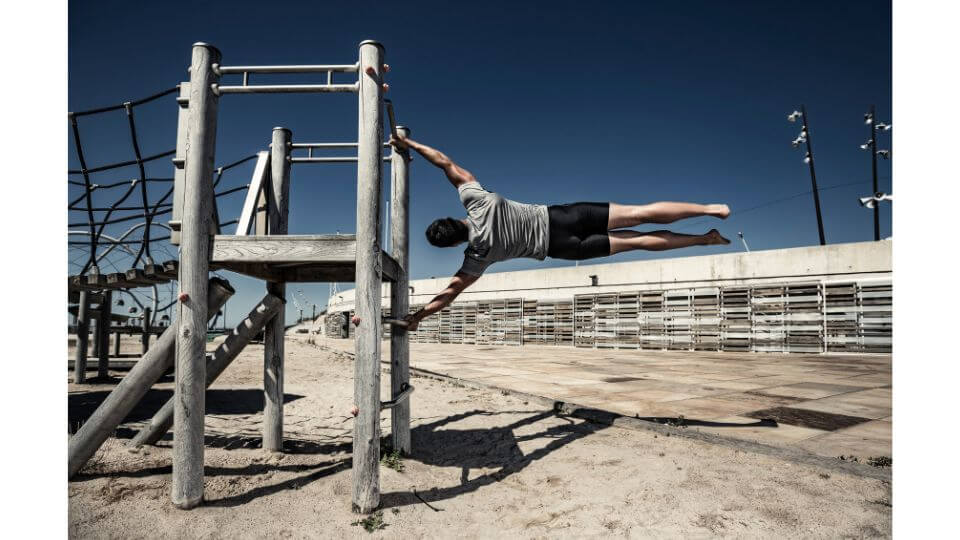
When performing a human flag, the bottom arm is turned to grip the pole and is straight to "push" the body up, while the top arm faces forward and grips the pole. This arm "pulls" the body to maintain a parallel position to the ground. Easier variations of this move include hooking one arm over the pole or having the legs straddled, tucked or raised. The best way to learn the hold is by starting with the legs parallel to the pole and then slowly lowering them to the ground. Tucking or straddling the legs can alleviate pressure on the abdomen and make the move much easier to hold.
Planche
The planche is a static hold that requires a great deal of upper body strength and balance. It involves holding the body in a plank position but with the hands close to the hips, and the feet off the ground.

To perform the planche, begin by supporting your body on your hands with your legs extended out behind you and your body parallel to the ground. Keep your core engaged and maintain proper form throughout the exercise. This exercise is considered difficult due to the need to maintain the isometric contraction of the body and the balance required.
Front Lever
The front lever is a calisthenics move, which is a static hold typically performed on the still rings or pull-up bar. It can be executed by lowering from an inverted hang until the body is completely horizontal and straight with the body parallel to the ground and front of the body facing upwards. Experienced athletes may be able to pull directly into the horizontal position from a dead hang. This move requires a high degree of back and core strength.
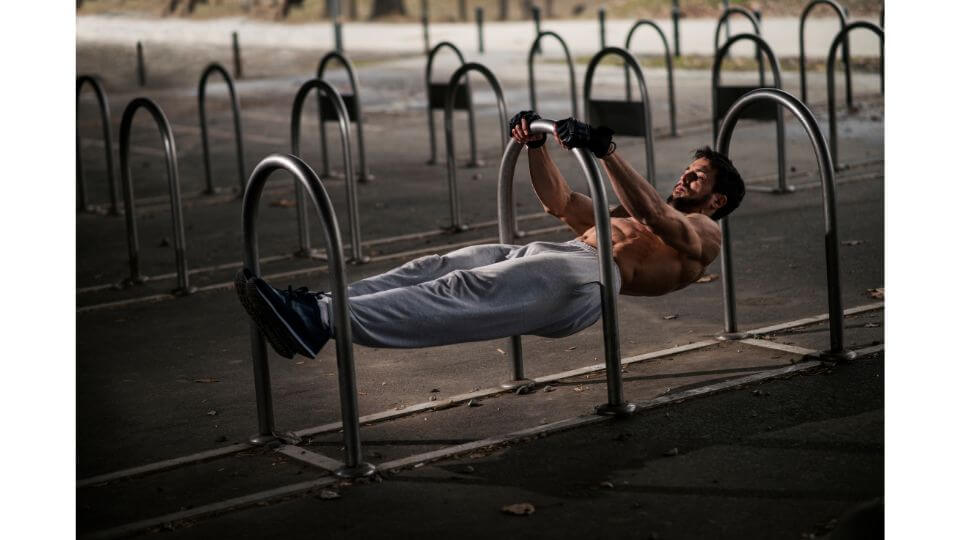
The Front Lever is a versatile calisthenic move that has several variations, starting from the easiest, which is the tuck front lever, and progressing to more advanced variations such as the advanced tuck variation where the knees are pushed slightly outwards while the back is flat, single leg front lever, straddle front lever, and finally the full front lever. As one progresses in learning the skill, gymnasts can perform pull-ups in the front lever position of their choice.
Back Lever
A back lever is a skill that involves hanging from a bar or rings with your body extended out parallel to the ground, supported by your hands.
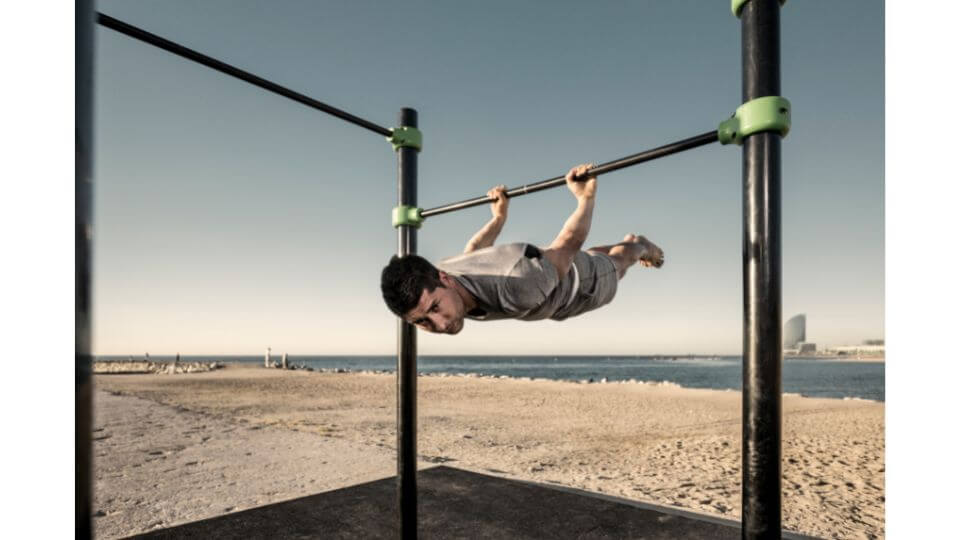
The back lever exercise primarily targets the muscles of the shoulders, lats, and core, including the rectus abdominis, obliques, and lower back muscles. It also engages the triceps and the posterior deltoids. It is a challenging exercise because it requires the ability to control your body in an inverted position which can be useful in other exercises and activities, such as climbing and gymnastics.
Conclusion
As a beginner in calisthenics, you might look at these challenging moves and feel they’re out of reach – but remember, everyone starts somewhere. Achieving these impressive skills isn’t about rushing or attempting advanced moves right away; it’s about consistent training, building foundational strength, and gradually improving flexibility. Focus on learning proper form and mastering basic movements first. Each workout brings you closer to these advanced exercises, so stay dedicated, trust the process, and celebrate the small wins along the way.
We also started compiling a comprehensive 🤸♀️ calisthenics exercise library—currently with over 100 beginner-friendly exercises—which we will continue to expand over time.
Following a well-designed workout plan tailored for beginners is key to your progress. Prioritize exercises that develop strength, coordination, and flexibility, as these will give you the foundation needed for the more advanced moves you aspire to. With patience and dedication, you’ll be amazed by how much you can achieve. Stay committed, train smart, and remember: every repetition brings you one step closer to mastering these inspiring calisthenics skills. Keep pushing forward – the journey itself is incredibly rewarding!

